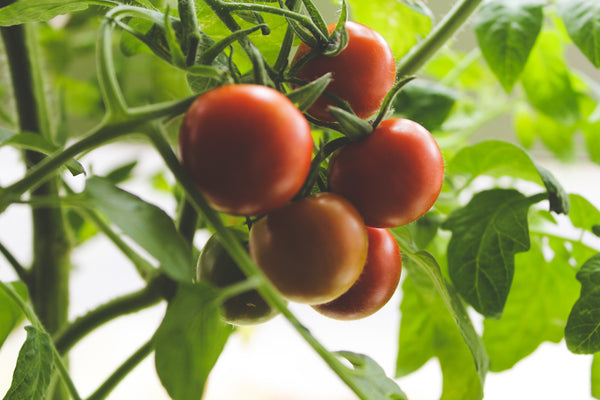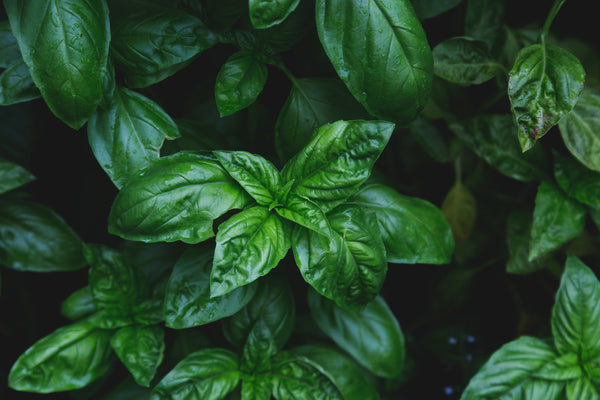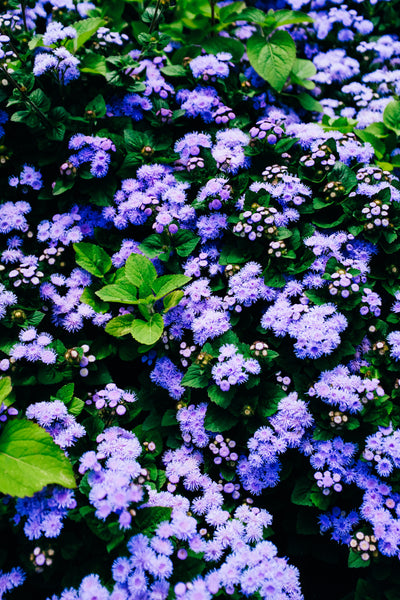Summer-ripened tomatoes are a good source of vitamin C and beta-carotene. The lycopene in the tomatoes is an anti-oxidant, but is only released when the tomatoes are cooked. They also contain compounds that block cancer-causing nitrosamines. We use the convention of Bush to mean determinate (fruit set more or less all at once on short plants). Vine means indeterminate (fruit sets over a longer time on tall-growing plants).
When I Get My Seedling Home
Keep seedlings under very bright light to prevent legginess. Artificial lights are ideal, but a bright (ideally, south-facing) room will work for the short term. You may have to pot on seedlings more than once before they go out to allow for root growth. This is done by transplanting them into a slightly larger container with enough additional soil to keep the container mostly full. Keep the soil moist by daily watering and allow for free drainage so the plants are never sitting water.
Transplanting
Do not transplant outside until night time temperatures are steadily 10°C (50°F) or warmer. This may mean keeping seedlings indoors for up to a month. The plants should not require any fertilizer until transplant time.
Tomatoes thrive in fertile, well-drained soil that is high in organic matter. Dig in finished compost and/or manure, and add 1 cup complete organic fertilizer beneath each transplant. Dig a hole in the garden approximately the same size as the seedling container, or a couple of inches deeper. Invert the seedling and gently tease it from its container by holding the stem and supporting the root ball. Tomato seedlings can be transplanted either to the same depth of their container, or slightly deeper, up to the first set of leaves. Press the root ball into the soil, fill in with soil, and water thoroughly.
Growing
Space bush (determinate) transplants 45-60cm (18-24″) apart and vine (indeterminate) types 50-75cm (20-30″) apart in rows 1m (3′) apart. Tomatoes are tropical plants so they require full sun and lots of heat. Vine varieties will require some kind of support such as a wire to grow up, or a trellis to be tied to as the plant grows. Bush types benefit from the support of a tomato cage in order to prevent sprawling. At the time of final transplant, plants can be buried up to their first pair of true leaves. This will encourage greater root growth, helping with both nutrient uptake and the plants’ ability to stand up to dry conditions.
Reduce watering around the end of July to encourage the fruit to ripen. If your plants are grown under cover, you can encourage pollination and fruit set by tapping the stem from time to time. Tomatoes do not rely on insects for pollination. Vibrating the plant shakes pollen loose within the flowers, which then self-pollinate.
Harvest
Harvest when the fruit is the desired colour. Green tomatoes can be ripened indoors at a cool temperature when they are blemish free. Very dark green tomatoes are unlikely to ripen fully.
Diseases & Pests
Blossom End Rot is an environmental disorder caused by a calcium deficiency. As the name of the disorder indicates it occurs at the blossom end of the fruit. It appears as a brownish dry and firm sunken area. Sometimes a secondary infection can occur at the damaged area, which turns it mushy and wet. Internal blackening can occur without the characteristic end rot. Calcium deficiency can happen when there is uneven watering. When the plants are too dry for a period followed by over watering, this encourages fast growth. The tomato plant can’t take up enough calcium resulting in an unbalanced potassium-to-calcium ratio. Early fruit show the affects sooner than later fruit. Digging in bonemeal, dolomite lime and a balanced organic fertilizer such as Gaia All Purpose Blend 4-4-4 will help prevent this disease as will an even and regular watering schedule.
An airborne fungal disease causes Late Blight. It begins as leaf spots before spreading to stems and fruit. Water soaked areas appear on the leaves. These are greenish black and irregular in shape. Brown cankers develop on the stems and fruit. Blight infected tomatoes can have a fishy smell. Often the fruit manages to almost reach maturity before the cankers take over. Sometimes a bluish grey mould grows on the underside of infected leaves and on the fruit cankers.
Prevention is key as there is no cure for the disease. Keep moisture off the plants. Use drip tape for watering and avoid splashing the leaves. Our cloche system is excellent for keeping rain and moisture off the plants. In a greenhouse or under a cloche, humidity can build up so high that the fungus will destroy plants in 24 hours. You must ventilate well.
General Information on Late Blight: (Phytopthera infestans) is the fungus that infects tomatoes and potatoes, and is dreadful on the Coast. Greyish black areas appear first on stems and leaves, moving rapidly to kill the plant. The critical factor is moisture. Blight infects tomato plants with leaves and stems that are moist for over 48 hours. Moisture can be rain, heavy dew, high humidity in a greenhouse or cover, condensation, or irrigation water. Once you know this, you can plan a shelter under an overhanging eve, on a porch or under a structure that you create. The protection must have excellent ventilation and must give you access to pick and prune your tomatoes. Consider growing your tomatoes in containers that can be moved to sheltered spots out of the rain
Prevention of Late Blight: Late blight overwinters in tomato and potato debris. Do not plant in a bed that held tomatoes or potatoes last year, and dispose of diseased plants in the garbage not the compost. Copper spray can prevent the fungus from infecting the plant. Plants must be sprayed every 7-10 days before any symptoms appear. Blight strikes in the rains of late summer, so choose at least one variety that will ripen before the deluge. The best advice we can offer to avoid blight is to grow early ripening bush varieties and to protect your vines carefully.
Flea Beetles make many tiny holes in the tomato leaves. They can cause problems for small tender transplants but a healthy plant can usually outgrow the damage. Use our Floating Row Cover for early season protection from Flea Beetles when transplanting your tomatoes.
Companion Planting
Another sensitive plant when it comes to companions, tomatoes benefit from asparagus, basil, beans, borage, carrots, celery, chives, collards, cucumber, garlic, lettuce, marigold, mint, nasturtium, onion, parsley, and peppers. Avoid planting alongside Brassicas and dill. Corn will attract tomato pests, and kohlrabi will stunt tomatoes’ growth. Potatoes may spread blight to tomatoes, so keep them apart. Do no plant tomatoes near walnut trees.
More on Companion Planting.



